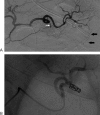Splenic artery embolization in blunt trauma
- PMID: 23729986
- PMCID: PMC3444871
- DOI: 10.1055/s-0032-1312577
Splenic artery embolization in blunt trauma
Figures


References
-
- Smith H E Biffl W L Majercik S D Jednacz J Lambiase R Cioffi W G Splenic artery embolization: Have we gone too far? J Trauma 2006613541–544.; discussion 545–546 - PubMed
-
- Tinkoff G, Esposito T J, Reed J. et al.American Association for the Surgery of Trauma Organ Injury Scale I: spleen, liver, and kidney, validation based on the National Trauma Data Bank. J Am Coll Surg. 2008;207(5):646–655. - PubMed
-
- Shanmuganathan K, Mirvis S E, Boyd-Kranis R, Takada T, Scalea T M. Nonsurgical management of blunt splenic injury: use of CT criteria to select patients for splenic arteriography and potential endovascular therapy. Radiology. 2000;217(1):75–82. - PubMed
-
- Bessoud B, Denys A, Calmes J M. et al.Nonoperative management of traumatic splenic injuries: is there a role for proximal splenic artery embolization? AJR Am J Roentgenol. 2006;186(3):779–785. - PubMed
-
- Schnüriger B, Inaba K, Konstantinidis A, Lustenberger T, Chan L S, Demetriades D. Outcomes of proximal versus distal splenic artery embolization after trauma: a systematic review and meta-analysis. J Trauma. 2011;70:242–260. - PubMed
LinkOut - more resources
Full Text Sources
Other Literature Sources

